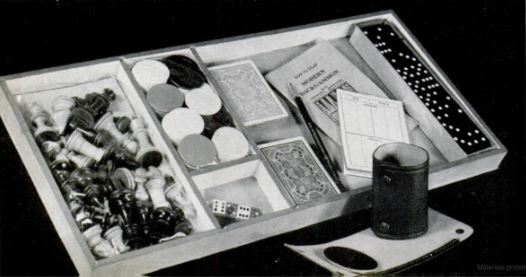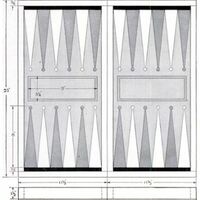-
Title (Dublin Core)
-
Portable games for men in service
-
Article Title and/or Image Caption (Dublin Core)
-
Title: Games...wherever and whenever you want to play them
-
extracted text (Extract Text)
-
MEN in Army camps and civilians work-
ing under high pressure in defense
industries stand in great need of adequate
recreation. They must have their games.
It is, fortunately, quite easy to provide fa-
cilities for a number of games by construct-
ing the type of combination playing board
and game kit illustrated. This is a compact,
portable, self-contained unit for chess,
checkers, backgammon, cards, dominoes,
and other games.
The kit is constructed in two halves, each
being a shallow box. These are hinged to-
gether to form the playing board when they
are open. Unlike other folding game boards,
they can be locked rigidly in the open posi-
tion so that they provide a firm, level play-
ing surface which can be supported on the
knees of the players, if necessary, without
any danger of “breaking” at the hinge and
upsetting. This is a great advantage in
such places as tents or barracks, or on a
train journey or an outing, when there is no
table available.
The equipment for the games is packed
in a tray, which fits into one section of the
playing board. The other half of the board
may be used for holding additional games,
magazines, cigarettes, or other small articles.
When closed, the game kit is a box 3 1/4”
by 11 1/2” by 23” and is carried like a small
suitcase. The sides are 3/4” thick, and are
preferably of maple, birch, or some other
hardwood. The top and bottom are made of
1/8” thick plywood or pressed composition
wood.
The simplest way to assemble the box is
to cut two pieces 3/4” by 33/16” by 23” and
two pieces 3/4” by 33/16” by 10” and glue
and nail them together to form an open
frame. Drill holes for the nails to avoid
splitting the wood, and be sure that the
corners are perfectly square. Then glue and
nail on the top and bottom, and plane the
edges of the plywood exactly flush. The
completely inclosed box thus formed can
then be sawed in half to form two shallow
boxes. A circular saw may be used, if one
is available, or a line can be drawn around
the box where the joint is to come, and a
handsaw used to split the line. The sawed
edges are then dressed smooth with a plane.
There are, of course, other ways to make
the game board. We wished the first one
we constructed to be very strong and work-
manlike, so we used dovetail joints. As the
stock we were using happened to be 3/4" by
1 1/2" maple, we had to make the two sections
separately. We laid out the dovetails on the
ends of the eight pieces with the aid of a
sheet-metal template, thus assuring accur-
acy and speeding up the work.
When glued joints are used, without nails
or screws, it is important to clamp the parts
firmly until the glue sets. If regular clamps
are not available, it takes only a few min-
utes to improvise a jig in which the frame
can be clamped by using wooden wedges.
Before the two halves are hinged together
with a pair of 2” narrow butts, it is neces-
sary to install the device for locking the
board in the open position. This consists of
two bolts made from 1/4" diameter steel rod.
Each is 10 3/4" long and slides in a piece of
brass tube fastened to the inside of one of
the boxes as indicated. The end of each bolt
slides through holes in the hinge sides of
the two sections and passes into another
tube similarly placed in the other box. The
tubes and holes must, of course, be lined up
accurately or the bolts will bind.
To prevent the bolts from falling out, pins
are driven into holes drilled near their ends.
When in the withdrawn position, each bolt
is held in place by a catch of spring metal,
which engages a shoulder cut or filed in the
rod. The bolts cannot slide until the catches
are moved. In the absence of a lathe or
other convenient means of shaping the ends
of the rod, a breast drill and file can be
used. Support the drill in a vise and the
end of the rod to be shaped in a jig, Which
can be made by boring a hole of the proper
size through a fairly heavy block—one
which can be held steady.
The tubes in which the bolts slide are each
held in place by two pipe straps. It is better
to make the pipe straps than to buy com-
mercial ones because those made in your
own shop can be cut a trifle too small and
bent so as to hold the tubes against the side
of the boxes very securely when the screws
are tightened.
The tray to hold the game equipment is
made with sides of 1/4" hardwood and a
bottom of 1/8” plywood. Overall, it is 1 1/4”
by 9 1/2,” by 20”. In any case, make the tray
to fit without too much play and be sure it
is at least as deep as the diameter of the
base of the largest chessman in the chess
set that is to be used. Partitions to keep the
equipment in place may be dadoed in or
simply nailed in wherever required, as il-
lustrated. (Continued)
-
Contributor (Dublin Core)
-
Charles Brownold (Article Writer)
-
Bertram Brownold (Article Writer)
-
Language (Dublin Core)
-
eng
-
Date Issued (Dublin Core)
-
1942-02
-
pages (Bibliographic Ontology)
-
145-149
-
Rights (Dublin Core)
-
Public Domain (Google Digitized)
-
Archived by (Dublin Core)
-
Roberto Meneghetti
-
Marco Bortolami (editor)
 Popular Science Monthly, v. 140, n. 2, 1942
Popular Science Monthly, v. 140, n. 2, 1942




